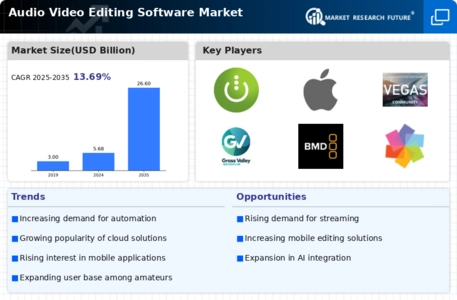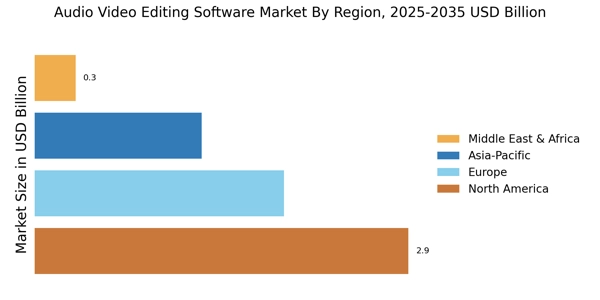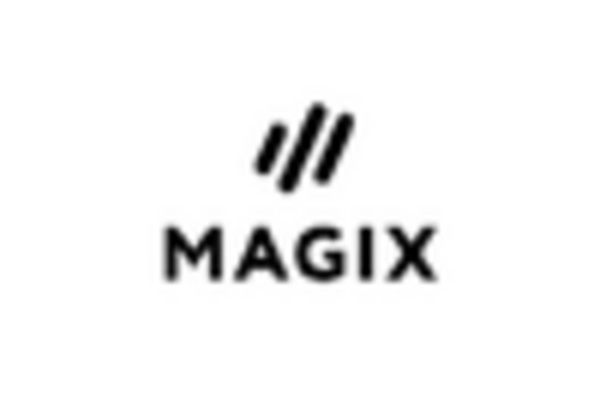Expansion of Social Media Platforms
The proliferation of social media platforms has profoundly influenced the Audio Video Editing Software Market. With platforms like Instagram, TikTok, and YouTube prioritizing video content, users are increasingly seeking tools that enable them to create engaging and shareable videos. This trend has resulted in a significant uptick in the number of individuals and businesses utilizing audio video editing software to enhance their online presence. Data indicates that video posts generate higher engagement rates compared to static images, prompting users to invest in editing software that can elevate their content. As a result, the Audio Video Editing Software Market is witnessing a robust growth trajectory, driven by the need for effective tools that cater to the demands of social media content creation.
Growing Popularity of Video Marketing
The growing popularity of video marketing is a significant driver for the Audio Video Editing Software Market. Businesses are increasingly recognizing the effectiveness of video as a marketing tool, leading to a surge in demand for editing software that can help create compelling promotional content. Research indicates that video marketing can lead to higher conversion rates and improved customer engagement, prompting companies to invest in quality editing solutions. As organizations strive to differentiate themselves in a competitive landscape, the need for professional-grade video content has never been more critical. This trend is likely to continue, propelling the Audio Video Editing Software Market forward as businesses seek to leverage video as a key component of their marketing strategies.
Increasing Demand for High-Quality Content
The Audio Video Editing Software Market is experiencing a surge in demand for high-quality content across various platforms. As consumers increasingly gravitate towards visually appealing and professionally edited videos, content creators are compelled to invest in advanced editing software. This trend is particularly evident in sectors such as marketing, entertainment, and education, where the quality of video content can significantly impact audience engagement. According to recent data, the demand for high-definition video content has led to a notable increase in the adoption of sophisticated editing tools, which are essential for producing polished and captivating videos. Consequently, this growing emphasis on quality is driving innovation and competition within the Audio Video Editing Software Market, as companies strive to meet the evolving expectations of users.
Rise of Remote Work and Online Collaboration
The shift towards remote work and online collaboration has significantly impacted the Audio Video Editing Software Market. As teams increasingly operate in distributed environments, the need for collaborative editing tools has become paramount. Software that allows multiple users to work on a project simultaneously is gaining traction, as it facilitates seamless communication and enhances productivity. This trend is particularly relevant in industries such as film production and marketing, where collaboration is essential for project success. Data suggests that the demand for cloud-based editing solutions is on the rise, as they offer flexibility and accessibility for remote teams. Consequently, the Audio Video Editing Software Market is adapting to these changing work dynamics by prioritizing features that support collaboration and remote access.
Technological Advancements in Editing Software
Technological advancements are playing a pivotal role in shaping the Audio Video Editing Software Market. Innovations such as real-time collaboration features, enhanced user interfaces, and integration with artificial intelligence are transforming the editing experience. These advancements not only streamline the editing process but also empower users to produce high-quality content with greater efficiency. For instance, the introduction of AI-driven tools that automate tasks like color correction and audio enhancement has made professional-grade editing accessible to a broader audience. As technology continues to evolve, the Audio Video Editing Software Market is likely to see an influx of new features and capabilities, further driving user adoption and satisfaction.


















Leave a Comment